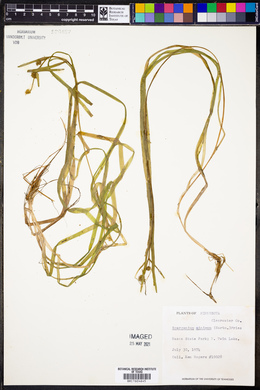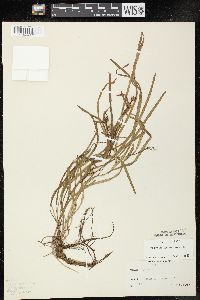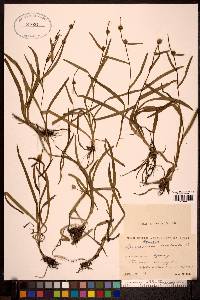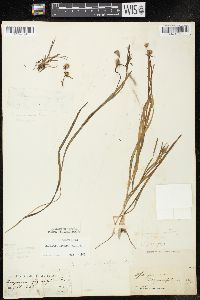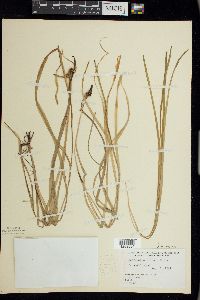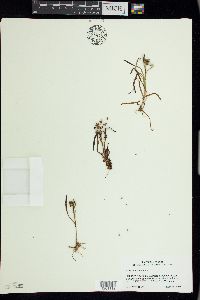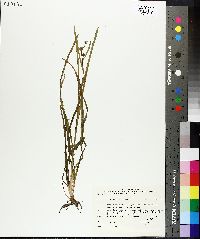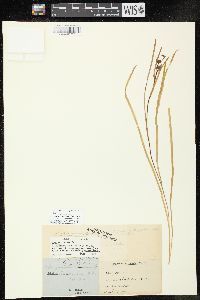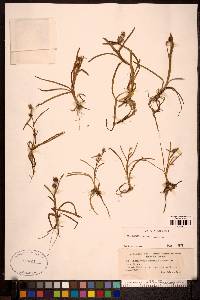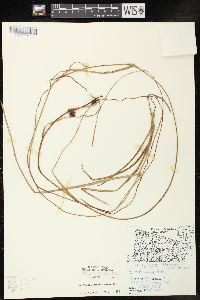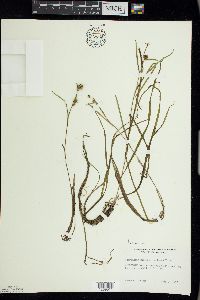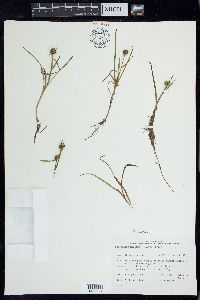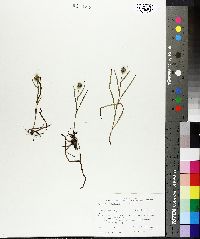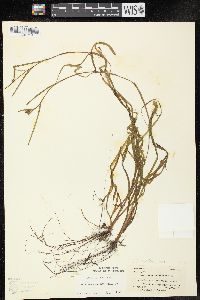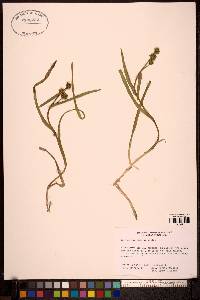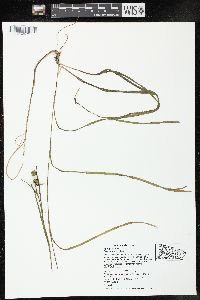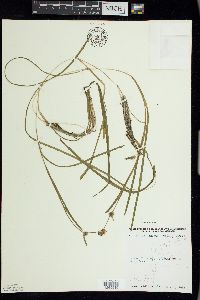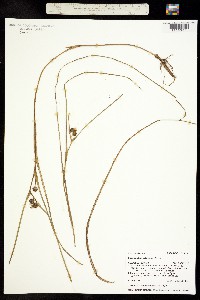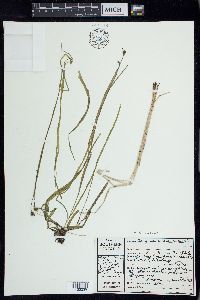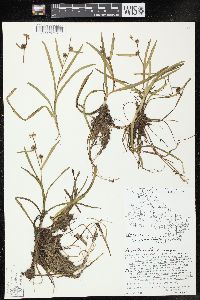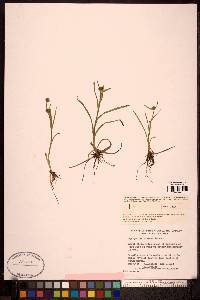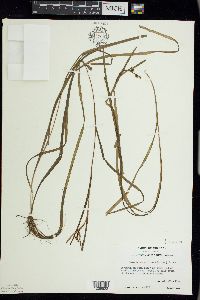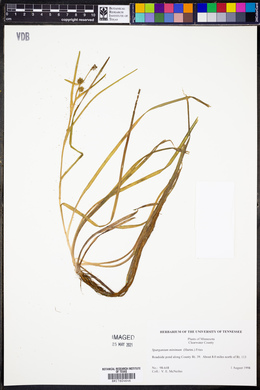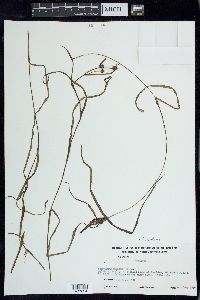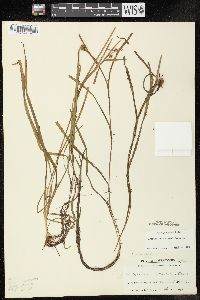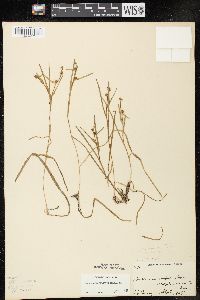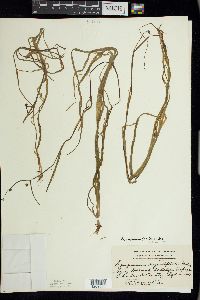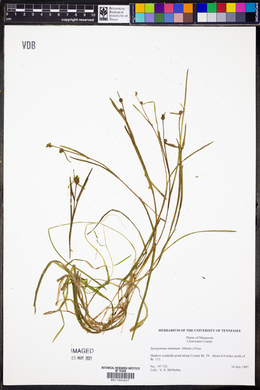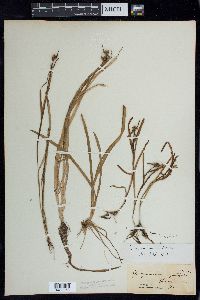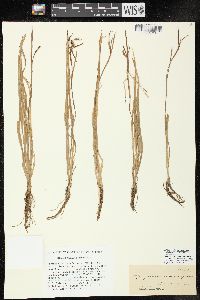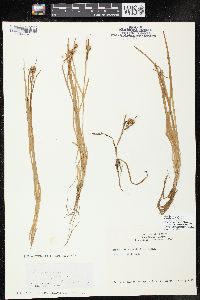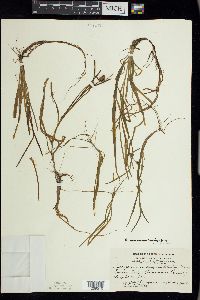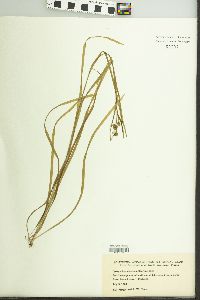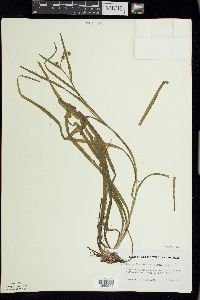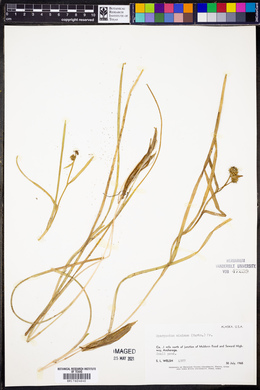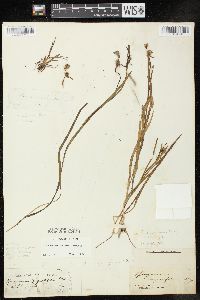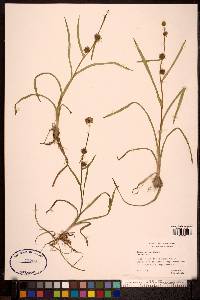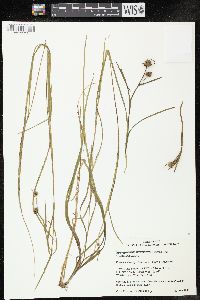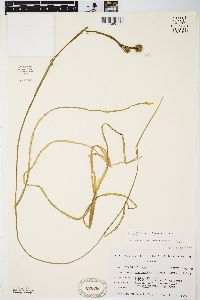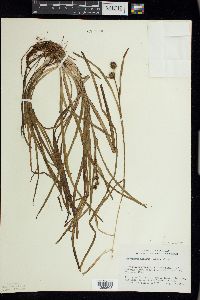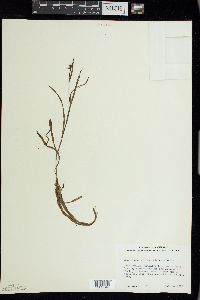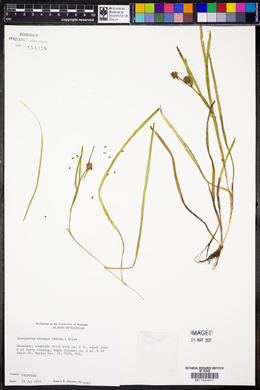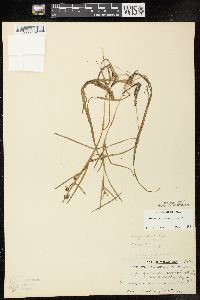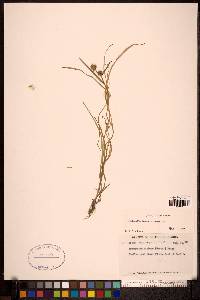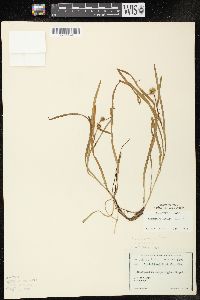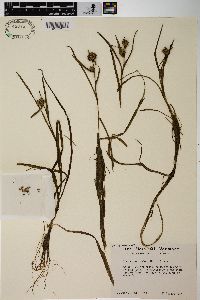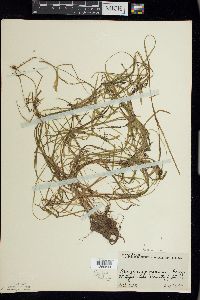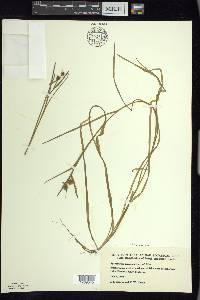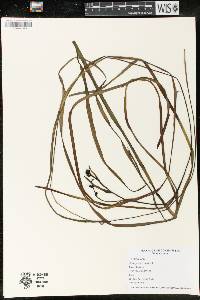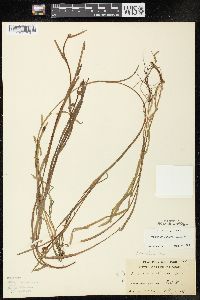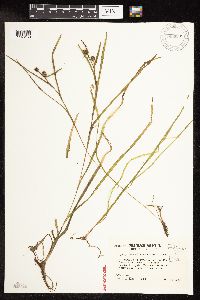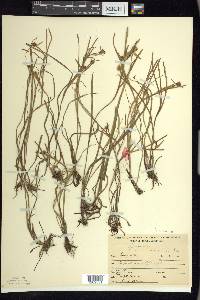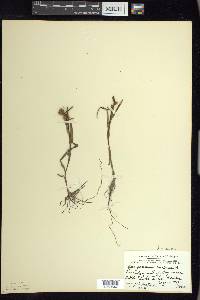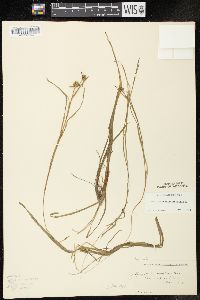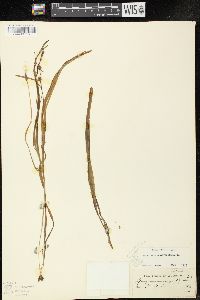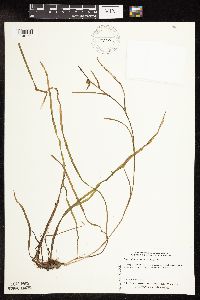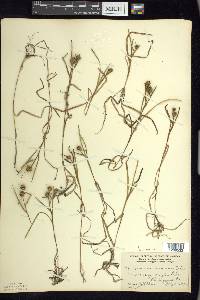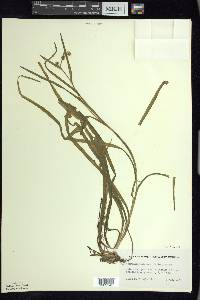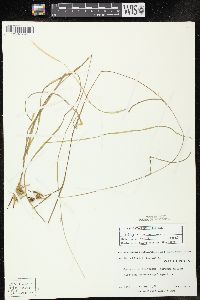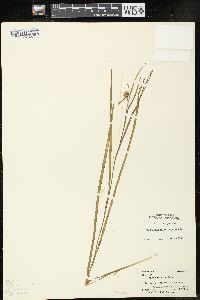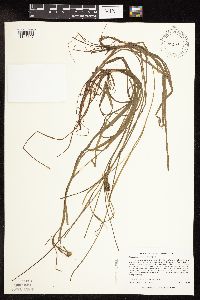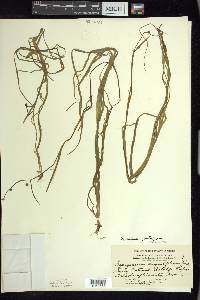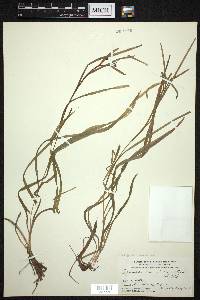Sparganium natans
|
|
|
|
Family: Typhaceae
Arctic Burr-Reed, more...small bur-reed
[Sparganium minimum (Hartman) Wallr., moreSparganium natans var. minimum L.] |
Plants slender, grasslike, limp, to 0.6 m; leaves and inflorescences floating or, when stranded, more or less erect. Leaves limp in water, unkeeled, flat, 0.04--0.6 m 2--6(--10) mm; leaves of stranded plants shorter, firmer. Inflorescences: rachis unbranched, flexuous; bracts ascending, basally inflated; pistillate heads 1--3, axillary, not contiguous, sessile or most proximal short-peduncled (often long-peduncled in Alaska and nw Canada), 0.5--1.2 cm diam. in fruit; staminate head 1 or apparently so, terminal, not contiguous with distalmost pistillate head. Flowers: tepals without subapical dark spot, erose; stigmas 1, lance-ovate. Fruits dark greenish or brownish, subsessile, body ellipsoid to obovoid, not faceted, barely or not constricted at equator, 2--4 1--1.5 mm, tapering to beak; beak curved, 0.5--1.5 mm; tepals attached at base, reaching about to equator. Seeds 1. 2n = 30. Flowering summer--fall (Jun--Sep southwestward, Jul--Aug northward). Cool, quiet, slightly acid to somewhat basic waters of bays, pools, ditches, and peat bogs, usually in shallow water but sometimes to 60 cm depth, where less floriferous, abundant in its northern range, less so southward; 0--3500 m; St. Pierre and Miquelon; Alta., B.C., Man., N.B., Nfld. and Labr., N.W.T., N.S., Nunavut, Ont., P.E.I., Que., Sask., Yukon; Alaska, Calif., Colo., Conn., Idaho, Ill., Ind., Maine, Mass., Mich., Minn., Mont., N.H., N.Y., Oreg., Pa., R.I., Utah, Vt., Wash., Wis., Wyo.; circumboreal (not in Greenland). This species has long been known as Sparganium minimum, but although the correct name is S. natans (C. D. K. Cook 1985). The leaves of Sparganium natans are thinner and more translucent than those of the similar S. hyperboreum, and they lack the yellowish cast of that species. Its distalmost pistillate head is not contiguous with the staminate head, as is sometimes the case in S. hyperboreum, and its beaked fruit also distinguishes it from that species. See the discussion under S. hyperboreum for a description of S. hyperboreum S. natans.
STEMS: 1 8( 10) dm long, slender, submersed and floating, or weakly suberect, not obviously branched. LEAVES 1 8( 10) dm long, (2 )3 6( 8) mm wide, about as long as the inflorescence, flat, without an evident keel, usually flaccid, dark green. INFLORESCENCE: simple, rarely over 6 cm long, the upper heads solitary, staminate, or with both staminate and pistillate flowers; lowermost heads pistillate or mixed, 1 3 in upper axils, 0.8 1.5 cm in diam. when mature, on slender pedicels 1 6 cm long. STAMINATE FLOWERS: perianth scales oblanceolate, 1 1.2 mm long, the apex essentially entire; anthers 0.3 0.6 mm long, 0.1 0.3 mm wide, broadly elliptic. PISTILLATE FLOWERS: perianth scales elliptic to cuneate spatulate, 1/2 2/3 as long as the achene; styles simple; stigma 0.8 1 mm long. sessile or stipitate, 3.5 5 mm long including the 1 1.5 mm long beak and stigma, ellipsoid to obovoid fusiform, the body somewhat centrally constricted; stipes, if present, 0.7 0.9 mm long. 2n = 30 NOTES: Shallow water of lakes: Coconino co.; ca. 2450 m (8200 ft.); Jun Sep (fr. Jul Oct); temperate n hemisphere. REFERENCES: Ricketson, Jon. 2001. Sparganiaceae. J. Ariz. - Nev. Acad. Sci. Volume 33(1). Perennial aquatic herb to 0.6 m tall Leaves: floating, 4 cm to 0.6 m long, 2 - 6 mm wide, flat, limp, lacking a longitudinal fold. The leaves of stranded plants are erect, shorter, and firmer. Inflorescence: floating, bracts ascending and inflated near base, main axis unbranched and flexible. The single terminal male flower head does not touch the uppermost female flower head. The one to three axillary female flower heads are short-stalked (lowermost) or stalkless and not tightly clustered. Flowers: tiny, with one narrow egg-shaped stigma and tepals lacking a dark spot near the unevenly cut tip. Fruit: a single-seeded achene-like drupe borne on a head 0.5 - 1.2 cm across, dark greenish or brownish, 2 - 4 mm long, 1 - 1.5 mm wide, elliptic to inversely egg-shaped, tapering to a curved beak 0.5 - 1.5 mm long, slightly or not constricted at the middle, the persistent tepals extending to the middle. Similar species: Sparganium eurycarpum is easily distinguished by having two stigmas in most female flowers and inverse pyramidal fruit. Sparganium americanum and Sparganium androcladum have erect, emersed leaves and inflorescences, and the inflorescences are branched. Sparganium emersum has more than two male flower heads and a 2 - 4.5 mm fruit beak. Sparganium angustifolium has a 1.5 - 2 mm fruit beak and more than two male flower heads, although the heads are tightly clustered and may appear as a single elongate head. Flowering: July to August Habitat and ecology: Rare in shallow water. Occurence in the Chicago region: native Etymology: Sparganium comes from the Greek word sparganion, a derivation of the word sparganon, meaning swaddling-band. This refers to the ribbon-like leaves of these plants. Natans means floating. Author: The Morton Arboretum Stems usually long and floating, varying to erect and 1-3 dm; lvs thin, flat, 2-7 mm wide, much elongate when floating; pistillate heads 1-3, axillary, sessile or the lowest rarely short-peduncled, 1 cm thick when ripe; tep narrowly spatulate, erose at the tip, reaching beyond the middle of the fr; achene sessile or nearly so, dull greenish or brownish, the body elliptic-obovoid, 3-4 mm, scarcely constricted, acute, the slender beak 0.5-1.5 mm; staminate head normally 1, separate; anthers oblong, 0.3-0.8 mm; 2n=30. In shallow water; circumboreal, s. to N.J., Pa., n. Ind., and N.M. (S. minimum) Gleason, Henry A. & Cronquist, Arthur J. 1991. Manual of vascular plants of northeastern United States and adjacent Canada. lxxv + 910 pp. ©The New York Botanical Garden. All rights reserved. Used by permission. From Flora of Indiana (1940) by Charles C. Deam Indiana Coefficient of Conservatism: C = 10 Wetland Indicator Status: OBL |


